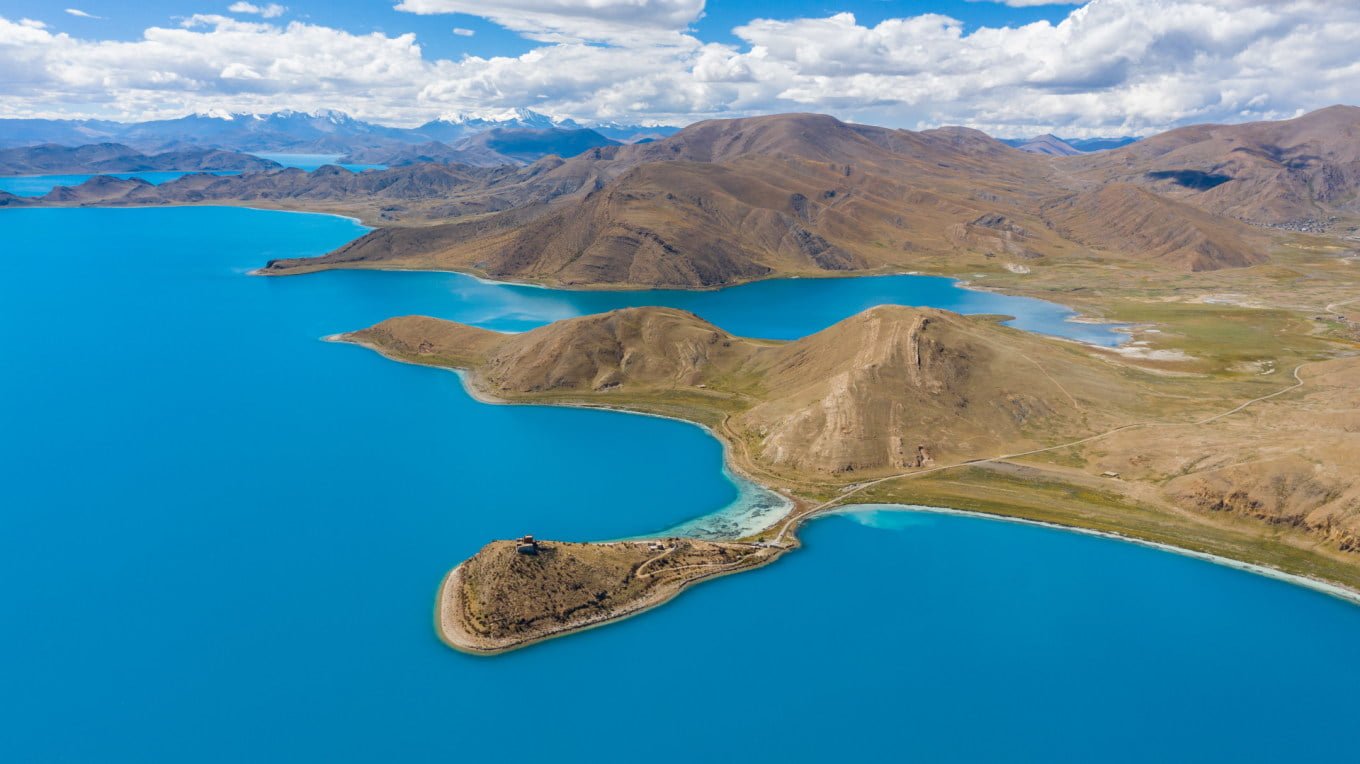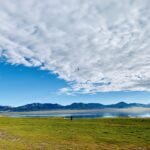The Majestic Yamdrok Lake: A Jewel of Tibet
Yamdrok Lake, locally known as “ཡར་འབྲོག་གཡུ་མཚོ་” stands as one of Tibet’s most famous and sacred lakes. In Tibetan, “Yamdrok” translates to “Upper Side,” “Yu” means “Turquoise,” and “Mtsho” signifies “Lake,” collectively describing it as the “Upper Turquoise Lake.” Officially named “Auspicious Yamdrok Yumtso Lake” and commonly referred to as “Yamdrok,” it is a marvel of natural beauty.
A Geographic Masterpiece
Located in Nagartse County near the southern bank of the Yarlung Tsangpo River, the lake is situated at an altitude of 4,441 meters. Stretching 130 kilometres in length, and 70 kilometres in width, and with a shoreline of 250 kilometres, Yamdrok Lake spans an impressive 638 square kilometers. With average depths ranging between 20 to 40 meters and reaching up to 59 meters at its deepest point, it is the largest inland lake on the northern side of the Himalayas.
Yamdrok Lake: A Natural Wonder
The lake snakes through the mountains for over 130 kilometres, resembling a uniquely shaped earring nestled on the earlobe of the mountains. Local Tibetans revere it as the “Turquoise Earring dropped by a Goddess,” reflecting its spiritual significance. Under different sunlight conditions, the lake displays a rich spectrum of blue hues, creating a dreamlike ambience.
Cinematic Beauty and Lush Surroundings
Yamdrok Lake gained additional fame as a filming location for the popular Chinese movie “Painted Skin: The Resurrection.” Its enchanting landscape significantly enhanced the movie’s visual appeal. The lake’s surroundings are lush with vegetation and vast grasslands, spanning over 10 million acres, making it one of Tibet’s renowned natural pastures.
Legends of Yamdrok Lake
Equally revered with Namtso in Northern Tibet and Mapam Yumtso, Yamdrok Lake is one of the “Three Great Holy Lakes” on the Tibetan Plateau. Rich in myth and legend, it is said to be the transformation of a celestial maiden. Others believe the lake was much larger in ancient times.
Originally called “The Turquoise Lake of the Pasture,” its numerous branches and coral-like shape led to the name “Yamdrok Yongtso Lake.” Nearby lies a small stone hill, entwined with legends of a demon who lusted after the lake’s fairy. Guru Rinpoche, a revered figure in Tibetan Buddhism, transformed this evil demon into a stone hill, condemning him to eternally repent by the lake’s pure and virtuous fairy.
Embark on a journey to Yamdrok Lake and immerse yourself in its mystical allure, deep-rooted legends, and breathtaking natural beauty.
The Romantic Legend of Yamdrok Lake: A Tale of Transformation
The Enchanting Origin Story of Yamdrok Lake
Yamdrok Lake, a place of breathtaking beauty in Tibet, is not only known for its stunning vistas but also for a romantic legend rooted deep in its past. This tale tells of a time when the area where the lake now lies was not a lake at all, but a vast, lush grassland inhabited by many families.
The Tale of the Blind Elder and the Well
The story revolves around an old blind man who had dug a well near his home, sealing it with a lid tied with ox hair. He repeatedly instructed his grandson to ensure that the well’s lid was securely replaced after drawing water. However, one fateful day, the grandson forgot to cover the well.
During the night, the water from the well overflowed, submerging the entire fertile grassland. A water demon roared towards the people, swallowing thousands of souls and spreading its evil grasp in all directions, bringing a profound disaster to the Yarlung Tsangpo River area.
The Divine Intervention of Guru Rinpoche
In this dire moment, the compassionate Guru Rinpoche transformed into an auspicious white swan. With a few flaps of his wings, he stopped the overflow of water, trapping the water demon within it. The once grassy plains transformed into what is now known as Yamdrok Lake. To prevent the water demon from wreaking havoc again, Guru Rinpoche used his powers to build temples around the lake to subdue the demon.
Yamdrok Lake: A Magnet for Pilgrims and Tourists
Yamdrok Lake has long been a magnet for pilgrims and tourists alike. It’s said that its waters hold miraculous properties: rejuvenating the elderly, curing the sick for the middle-aged, and enhancing intelligence in children. For centuries, this sacred lake has been a site of worship for devotees and a place for tourists to pause and reflect. Every summer, groups of pilgrims and travellers trek to the lake’s shores, enduring long journeys to seek blessings from the divine.
The Formation of Yamdrok Lake
Resembling a paper fan, Yamdrok Lake is wide in the south and narrow in the north, with numerous inlets stretching like spider legs into the surrounding mountains. The lake is flanked by perennial snow-capped mountains, often shrouded in clouds and mist, revealing their majesty only in the early morning light. Yamdrok Lake comprises the ancient Yamdrok Lake, Kongmu Lake, Shen Lake, and Baji Lake. Formed due to geological shifts and fractures in the Himalayas during the geological era, these interconnected lakes were much larger and were part of an outflow lake system that drained into the Yarlung Tsangpo River via the Mochu near Yase.
Embark on a journey to Yamdrok Lake, a place of legend, natural wonder, and spiritual significance, nestled in the heart of Tibet’s majestic landscape.
The Evolution of Yamdrok Lake: A Geological Marvel
The Himalayan Uplift and Transformation of Yamdrok Lake
Approximately one million years ago, a dramatic geological event shaped the destiny of Yamdrok Lake. The mighty uplift of the Himalayan mountain range altered the region’s climate, leading to decreased rainfall and a significant drop in the lake’s water levels. The drainage channels that once connected the lake to outflowing water bodies became blocked. Additionally, massive mudslides near Yase, about 20 kilometres west of Baidi, obstructed the upstream valley of the Mochu River. Consequently, Yamdrok Lake transitioned from an outflow lake into an inland lake.
The Lake’s Unique Hydrological Characteristics
Located in the rain shadow zone of the Himalayas, Yamdrok Lake’s water levels gradually receded due to insufficient atmospheric precipitation and snowmelt. This change disconnected the lake from its southeastern neighbour, Zhugu Lake, and led to the segregation of the unified lake body into separate entities: Yamdrok Lake, Kongmu Lake, and Shen Lake, among others. The primary sources of water replenishment are rain, snow, and glacier melt, with runoff from rainfall and surrounding mountain precipitation accounting for approximately 70% of the total water input. The lake’s mineralization level is 1.7 grams per litre, classifying it as a slightly saline lake.
The Salinity Shift and Future Trends
Among the large and medium-sized inland lakes of Tibet, Yamdrok Lake has one of the lowest salinity levels. However, a chemical transformation is underway; it has evolved from a bicarbonate to a sulfate type, indicating a gradual transition towards becoming a salt lake in the future.

Yamdrok Lake Through the Seasons
In winter, Yamdrok Lake transforms into a serene beauty, encased in ice and lying peacefully amidst the Himalayan peaks, reminiscent of an elegant, snow-clad maiden. In summer, the lake’s deep blue waters mirror a dignified matron, nurturing the earth with her sweet waters. The shores of Yamdrok Lake are fertile grounds for growing highland barley, with yields exceeding 250 kilograms per mu.
The Myth of Gangbala Mountain and Yamdrok Lake
Legend has it that Gangbala Mountain and Yamdrok Lake are a loving couple who witnessed the hardship of their people, who had no access to highland barley. In the past, the inhabitants had to endure arduous journeys to trade for barley, often returning with very little. Moved by their plight, Gangbala, the mountain deity, risked his life to bring back a handful of barley seeds, which he scattered near his wife, Yamdrok Lake.
She nurtured these seeds with her waters, leading to the flourishing of barley in the region. To this day, locals offer tsampa (roasted barley flour) and butter to Yamdrok Lake at the start of the ploughing season, hoping for a bountiful harvest, a tradition passed down through generations.
Yamdrok Lake: Tibet’s Natural Fish Reserve
A Haven for Aquatic Life and Biodiversity
Yamdrok Lake, known as Tibet’s “natural fish reserve,” is abundant in high-level aquatic plants and provides a pristine habitat for various fish species. According to the fisheries department, the lake harbours an estimated 200 to 300 million kilograms of fish, making it a significant source of aquatic biodiversity in Tibet. The fish species found here belong to the Schizothoracinae subfamily, including the delicately flavoured Tibetan Schizothoracin, the Fine-Scaled Fish, and the Tibetan Naked Carp.
Tibetan Schizothoracin (Gymnocypris):
Also known as the “Bow Fish,” this species has an elongated, laterally compressed body, growing up to 25 cm in length and sporting a silver-grey colour. It has a terminal mouth without barbels and lacks keratinous projections on the lower jaw. The Tibetan Schizothoracin feeds primarily on zooplankton like cladocerans and copepods. Known for its thick, fatty meat with a rich flavour, it is a delicacy, consumed fresh or salted.
Fine-Scaled Fish:
This species, reaching lengths up to 80 cm, has a purple-grey back with black spots and a silver-grey belly. During the breeding season, the body colour darkens with red spots appearing. It has a small mouth with numerous teeth, including on the tongue. The Fine-Scaled Fish matures over 5-6 years, with sinking eggs about 4 mm in diameter, and feeds mainly on invertebrates. It is considered a valuable economic fish in Yamdrok Lake, known for its fatty meat and prized eggs.
Yamdrok Lake: The Largest Bird Habitat in Southern Tibet
Yamdrok Lake is not only a fish sanctuary but also the largest bird habitat in southern Tibet. Situated at an altitude of over 4400 meters, the lake attracts thousands of birds with its rich fish resources and lush lakeside vegetation, making it an ideal spot for nesting and raising offspring. The lake’s abundant fish population, in a self-sustaining cycle, provides ample food for a variety of bird species.
The lake’s vast and tranquil environment, free from the disturbance of wild animals and flourishing with flora, is a paradise for birds. Commonly seen species include graceful swans, squint-nosed Ruddy Shelducks, black-faced and white-winged Gulls, colourful Ruddy Shelducks, brown-headed and brown-legged Brown-headed Gulls, and skilled fish-hunting Cormorants. Other species such as wild ducks, Bar-headed Geese, Rock Pigeons, White-crowned Pigeons, Crested Pochards, and Gulls frequently form flocks, playfully roaming the lake’s surface.

Yamdrok Lake: A Sanctuary for Diverse Bird Species in Tibet
Thriving Avian Communities in Yamdrok’s Ecosystem
Yamdrok Lake, renowned for its ecological diversity, hosts a variety of bird species that thrive in its unique environment. These birds often live in groups within their species but form smaller family units for survival. As autumn winds herald the onset of winter on the Tibetan Plateau, these birds migrate south with their offspring, returning to the warmth of lower altitudes.
During the egg-laying season, the small islands in the lake become the largest natural egg-laying grounds in southern Tibet. Here, in this avian world, birds busily build nests and raise their young, especially when the warm currents from the Bay of Bengal signal the return of migratory birds from the South. Different species employ unique nesting strategies, from the diligent Bar-headed Goose building nests with dry grass to the resourceful Cormorant using materials from other nests, creating a diverse and vibrant ecosystem around Yamdrok Lake.
Key Bird Species of Yamdrok Lake
Swans (Cygnus):
Also known as “Hus,” the male swan can grow over 1.5 meters in length, with the female being slightly smaller. Swans have extremely long necks and pure white feathers. Their beaks are black at the tip and yellow at the base. They primarily feed on aquatic plants, supplemented by molluscs and small fish. Swans have a reputation for flying rapidly and at great heights, and people consume their meat, while artisans use their feathers to craft fans and make down quilts.
Wild Ducks:
Smaller than domestic ducks, wild ducks have webbed toes and are excellent swimmers. They are typically omnivorous, with a preference for plant-based diets. Wild duck meat is edible, and their feathers contribute to down production, making them significant economic waterfowl. Species include the Crested Pochard, Ruddy Shelduck, and Ruddy Shelduck.
Cormorants (Phalacrocorax):
Also known as “water crows” or “fish eagles,” cormorants can grow up to 80 cm in length. They have predominantly black feathers with a purple metallic sheen. During the breeding season, their heads and necks grow white filamentous feathers, while juveniles have black underparts with white feathers. Cormorants are skilled at diving and fishing.
Bar-headed Goose:
Characterized by grey feathers with three black stripes on the head, this species is one of 18 types of geese and ducks found in Tibet, accounting for over 39% of the national total. The Bar-headed Goose is renowned for its delicious and nutritious meat and eggs, and its feathers find use in down products. These geese form strong pair bonds, frequently grooming together, flying side by side, swimming together, assisting each other, and cuddling during rest. If one partner dies, the other remains single for life, a testament to their deep bond.
Rock Pigeons (Columba livia):
Also known as “mountain stone pigeons,” males can grow up to 35 cm in length. Their heads and necks are dark blue-grey with a metallic sheen of purple and green, forming a noticeable neck ring. They have black beaks and two distinct black bands on their folded wings. Rock pigeons usually flock together and feed on fruits, seeds, and grains. They are recognized for their rapid flight and brisk walking, and their meat is esteemed for its deliciousness.
Yamdrok Lake’s Hydroelectric Power Station
In addition to its ecological significance, Yamdrok Lake also plays a crucial role in energy production. With a storage capacity of 15 billion cubic meters, the Yamdrok Hydropower Station, completed in September 1998, generates an annual electricity output of 84.09 million kilowatt-hours. It provides power to the cities of Lhasa, Shannan, and Shigatse, making it an essential energy hub in southern Tibet.
Visiting Yamdrok Lake: Tips and Information
- Admission Fee Required: The lake is about 110 kilometres from Lhasa, and visitors can either hire a car from Lhasa, take a bus to Nagartse County, or drive themselves. Accommodations are available in county guesthouses, hotels, or hostels. Alternatively, visitors can stay in the quaint and welcoming village of Baidi near the lake or camp by the lake, provided they bring tents and sleeping bags.
- Viewing Points: The best views of Yamdrok Lake can be enjoyed by walking along the highway after passing Gangbala Pass. There are several viewing platforms along the way for photo opportunities. The right side of the road to Yamdrok Lake offers a view of the Yamdrok Hydropower Station, the world’s highest-altitude pumped storage power station and a vital energy resource for southern Tibet. The best time to visit is from July to September, during the summer, but visitors should avoid rainy days for the best visibility.
Embark on a journey to Yamdrok Lake, a haven for wildlife and a key part of Tibet’s natural and cultural heritage.



















